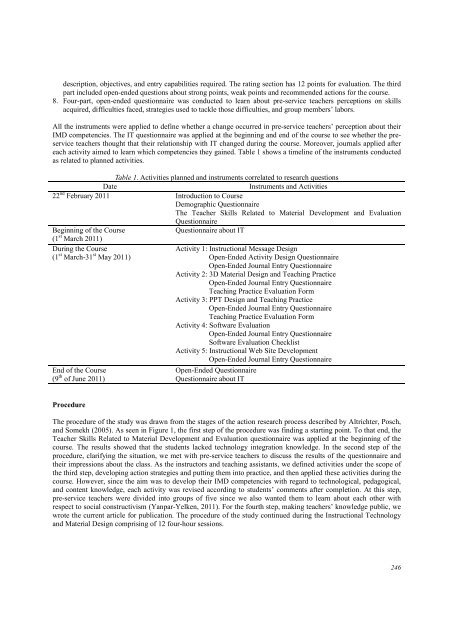Download Complete Issue in PDF - Educational Technology & Society
Download Complete Issue in PDF - Educational Technology & Society
Download Complete Issue in PDF - Educational Technology & Society
Create successful ePaper yourself
Turn your PDF publications into a flip-book with our unique Google optimized e-Paper software.
description, objectives, and entry capabilities required. The rat<strong>in</strong>g section has 12 po<strong>in</strong>ts for evaluation. The third<br />
part <strong>in</strong>cluded open-ended questions about strong po<strong>in</strong>ts, weak po<strong>in</strong>ts and recommended actions for the course.<br />
8. Four-part, open-ended questionnaire was conducted to learn about pre-service teachers perceptions on skills<br />
acquired, difficulties faced, strategies used to tackle those difficulties, and group members’ labors.<br />
All the <strong>in</strong>struments were applied to def<strong>in</strong>e whether a change occurred <strong>in</strong> pre-service teachers’ perception about their<br />
IMD competencies. The IT questionnaire was applied at the beg<strong>in</strong>n<strong>in</strong>g and end of the course to see whether the preservice<br />
teachers thought that their relationship with IT changed dur<strong>in</strong>g the course. Moreover, journals applied after<br />
each activity aimed to learn which competencies they ga<strong>in</strong>ed. Table 1 shows a timel<strong>in</strong>e of the <strong>in</strong>struments conducted<br />
as related to planned activities.<br />
Table 1. Activities planned and <strong>in</strong>struments correlated to research questions<br />
Date Instruments and Activities<br />
22 nd February 2011 Introduction to Course<br />
Demographic Questionnaire<br />
The Teacher Skills Related to Material Development and Evaluation<br />
Questionnaire<br />
Beg<strong>in</strong>n<strong>in</strong>g of the Course<br />
(1 st Questionnaire about IT<br />
March 2011)<br />
Dur<strong>in</strong>g the Course<br />
(1 st March-31 st May 2011)<br />
End of the Course<br />
(9 th of June 2011)<br />
Procedure<br />
Activity 1: Instructional Message Design<br />
Open-Ended Activity Design Questionnaire<br />
Open-Ended Journal Entry Questionnaire<br />
Activity 2: 3D Material Design and Teach<strong>in</strong>g Practice<br />
Open-Ended Journal Entry Questionnaire<br />
Teach<strong>in</strong>g Practice Evaluation Form<br />
Activity 3: PPT Design and Teach<strong>in</strong>g Practice<br />
Open-Ended Journal Entry Questionnaire<br />
Teach<strong>in</strong>g Practice Evaluation Form<br />
Activity 4: Software Evaluation<br />
Open-Ended Journal Entry Questionnaire<br />
Software Evaluation Checklist<br />
Activity 5: Instructional Web Site Development<br />
Open-Ended Journal Entry Questionnaire<br />
Open-Ended Questionnaire<br />
Questionnaire about IT<br />
The procedure of the study was drawn from the stages of the action research process described by Altrichter, Posch,<br />
and Somekh (2005). As seen <strong>in</strong> Figure 1, the first step of the procedure was f<strong>in</strong>d<strong>in</strong>g a start<strong>in</strong>g po<strong>in</strong>t. To that end, the<br />
Teacher Skills Related to Material Development and Evaluation questionnaire was applied at the beg<strong>in</strong>n<strong>in</strong>g of the<br />
course. The results showed that the students lacked technology <strong>in</strong>tegration knowledge. In the second step of the<br />
procedure, clarify<strong>in</strong>g the situation, we met with pre-service teachers to discuss the results of the questionnaire and<br />
their impressions about the class. As the <strong>in</strong>structors and teach<strong>in</strong>g assistants, we def<strong>in</strong>ed activities under the scope of<br />
the third step, develop<strong>in</strong>g action strategies and putt<strong>in</strong>g them <strong>in</strong>to practice, and then applied these activities dur<strong>in</strong>g the<br />
course. However, s<strong>in</strong>ce the aim was to develop their IMD competencies with regard to technological, pedagogical,<br />
and content knowledge, each activity was revised accord<strong>in</strong>g to students’ comments after completion. At this step,<br />
pre-service teachers were divided <strong>in</strong>to groups of five s<strong>in</strong>ce we also wanted them to learn about each other with<br />
respect to social constructivism (Yanpar-Yelken, 2011). For the fourth step, mak<strong>in</strong>g teachers’ knowledge public, we<br />
wrote the current article for publication. The procedure of the study cont<strong>in</strong>ued dur<strong>in</strong>g the Instructional <strong>Technology</strong><br />
and Material Design compris<strong>in</strong>g of 12 four-hour sessions.<br />
246

















